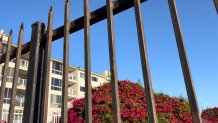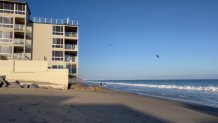Although Californians have legally had access to all beaches in the state since 1976, locals are still fighting for their rights to access Carbon Beach, also known as Billionaire’s Beach, in Malibu.
In 1972, Californians passed a voter initiative to regulate the development of the state’s coasts and preserve public access. By 1976, the state created the Coastal Commission to support these initiatives.
Even with these protections, the controversy over Carbon Beach is not unique. In the last two decades, private property owners and hopeful beachgoers have butted heads over accessing beaches from San Diego to San Francisco.
Now, one government agency is accusing another of not helping the public access beach at a condominium complex along Pacific Coast Highway called Malibu Outrigger.
Get San Diego local news, weather forecasts, sports and lifestyle stories to your inbox. Sign up for NBC San Diego newsletters.
The Mountains Recreation and Conservation Authority (MRCA)— a public agency committed to preserving, managing, and ensuring access to parks and beaches— called out the City of Malibu in an Instagram post for not yet approving a permit to build a public beach path at Outrigger.
A press release from the MRCA sent to NBC4 states that “the promised beach access languishes in the City of Malibu’s Planning Department awaiting approval for a building permit submitted by Outrigger in April 2023.”
Though Outrigger is under a five-minute walk to public access points on each side of the property, “It is an issue of equity to provide places for all people to access the beach for respite from the heat, to relax and exercise, and to simply enjoy our beautiful Malibu coast,” Elena Eger, Coastal Projects Special Counsel for the Mountains Recreation and Conservation Authority, said in the press release.
U.S. & World
When asked for an interview, Mark Myerhoff, the media information officer for the city, responded with the following statement: “The City of Malibu fully supports public access to beaches in Malibu, which is protected under state law, as it is for the entire coast of California.”
A representative for the Outrigger Homeowners Association declined to comment.

Why has this been a 50-year-long issue?
The story of this conflict between city and state officials and property owners begins in 1972, when the owners of a beach-side apartment building and motel in Malibu began the process of converting the property into a condo complex.
Coastal development meant its owners needed to apply for a permit from the Coastal Commission. In their submitted application, the owners wrote “The project will increase access to the beach by the granting of a 10-foot easement through the property for public access to the beach which does not now exist.”
Meanwhile, the owners had also signed a lease on a portion of a neighboring plot of land to build a private sewage system, parking lot, and concrete walls-- all of these additions were done without authorization from the Coastal Commission regulations, according to a 2019 report.
As the properties changed hands, with the Sterling Family Trust taking ownership of the land neighboring the now 42 owners of the Malibu Outrigger Condos, the two groups became engaged in a years-long legal battle over the use of the previously-leased plot.
The Commission alleges that Malibu Outrigger placed unauthorized rock riprap-- rocky material along the shore to protect the building from wear caused by the waves-- on both properties in the late 1980s. The rock riprap added to their list of coastal development violations and created another physical barrier preventing the public from accessing the beach. In the 2019 report, officials noted that this kind of construction “frequently results in increased erosion rates,” narrowing strips of sand “until eventually no beach is left.”
Some time before 2002, Outrigger extended the walls around the unpermitted parking lot and added a gate with a walkway from the lot to the beach on a path meant for the original easement. This gate gave the condo’s residents and their guests private beach access when it was intended for the public.
Between 2015 and 2017, the Coastal Commission, Outrigger, and Sterling met to discuss how to best resolve Coastal Act violations with existing city zoning and development regulations. In addition to having to pay fines, Outrigger agreed to finally build an accessway, upcoast from the original required easement.

How does beach access at Outrigger look right now?
Malibu Outrigger is in between two places where the public can access the beach. The first easement is .2 miles, or a four-minute walk, away from the property.
The other access is only .1 miles, or a two-minute walk, and is known as the Ackerberg Access, after the Ackerberg family.
Lisette Ackerberg had originally fought against opening an easement next to her home by saying it should instead be opened at the Outrigger complex as the Commission had originally planned. Ultimately, she lost and had to pay $1.1 million for the new easement.
Similar legal battles have taken place over accessing Carbon Beach, like in the case of DreamWorks co-founder David Geffen who kept the public from using a beach path by his home for 22 years.
In the MRCA’s press release, they included proposed areas where temporary and permanent public beach access paths could be added.
“The Commission requires a temporary “interim” access easement so the public can reach this beach during the development of the permanent access that includes benches and a shade structure,” the release states.
Outrigger submitted a building permit to the City of Malibu in April 2023, but there have been no known updates on a new easement.
“During one of the hottest times in history with almost daily heat advisories, people need access to Malibu beaches which are consistently about 20 degrees cooler than inland Los Angeles,” Eger said.



